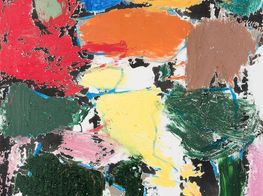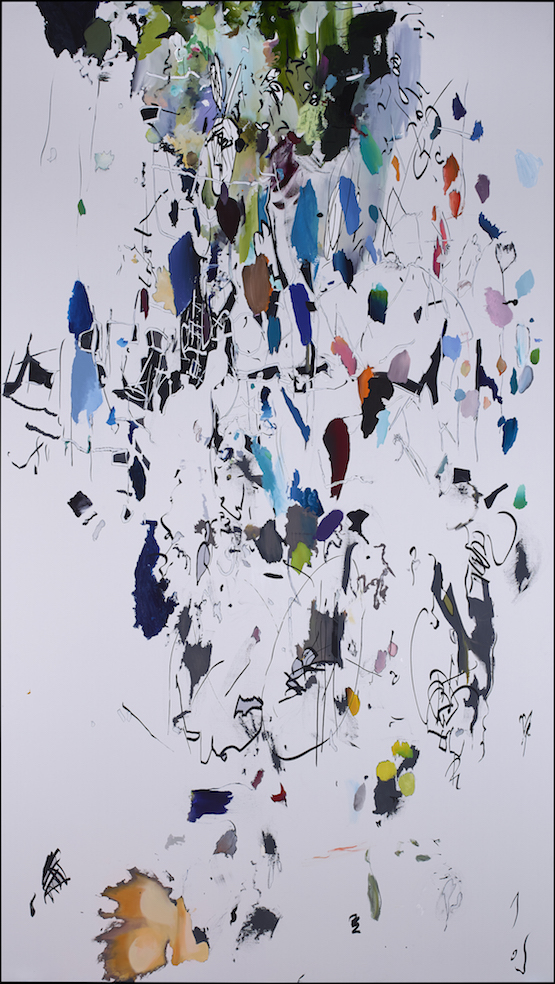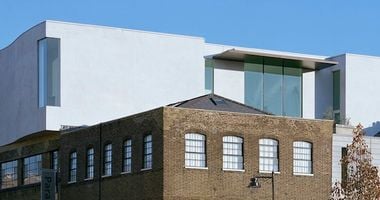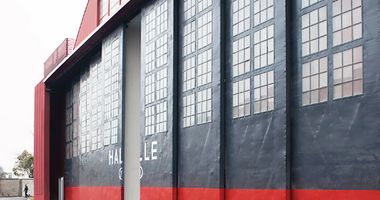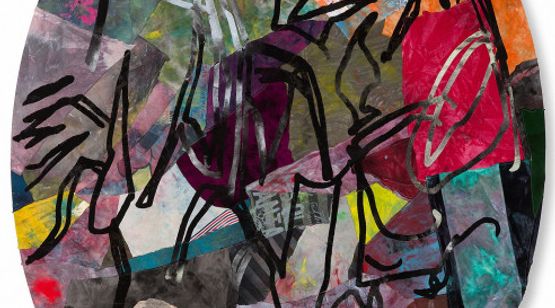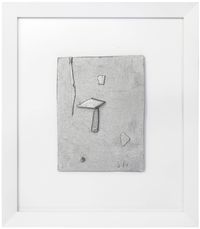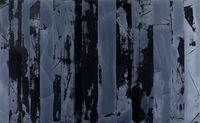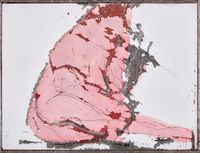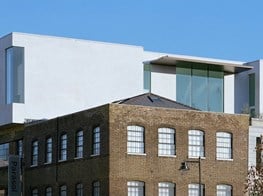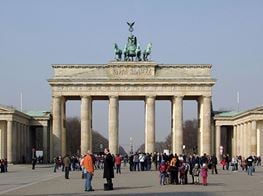Secundino Hernández
Secundino Hernández. Photo: Achim Hatzius
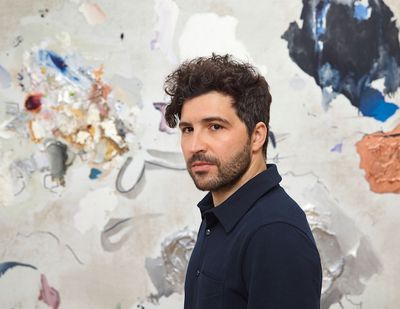
Secundino Hernández. Photo: Achim Hatzius
Upon meeting artist Secundino Hernández in his studio in Berlin, it becomes apparent that not only is his physical world multi-dimensional, but so too is his approach to making work. Spending half of his time between his hometown of Madrid—the city he grew up in and a metropolis he describes as 'grotesque' — and the other half in Germany's capital, encapsulates his artistic methodology.
There is a mental separation that occurs for the Spaniard when turning his attention to his art: Madrid is his production site and Berlin is a location reserved for contemplation. This is also evident in his paintings conceived from automatic drawings. Dualities are expressed in the conflation of representation and abstraction, the balance between perceived control and chaos, and optical continuity and variation.
Hernández's interest in mirroring his creative process speaks of the corporeal presence of the artist in work at once redolent of action-painting and expressionism. Each painting exists as a charged carrier of energy and platform for the facilitation of this transfer. His perspicacious approach to painting signals an ongoing confrontation with the medium of painting and its traditions, openly engaging in references to historical masters such as El Greco, Velázquez and Picabia. Playing a significant role in the trajectory of contemporary painting, he lays bare striking visual reveries on canvas.
Attracting strong international interest in recent years, today Hernández has little time for laboured contemplation. While discussing his newly completed body of work for his upcoming exhibition at the Yuz Museum in Shanghai (01 September—11 October, 2015), he shares insights into his underlying motivations and ideas for his art.
RVSecundino what do you love about sharing your time between Madrid and Berlin? Why is this so important for you?
SHI really enjoy both cities for different reasons. Each city has a different input and my way of living varies between both locations. Here in Berlin I have a small studio and big apartment. It is the opposite in Madrid where I have a huge studio and a very tiny apartment. In Berlin I have time for reflection, making sketches and finding some peace. In Madrid it is really crazy with friends, family and a social life with commitments. Madrid is grotesque in a way. When I am there I go directly to the production side of my work and I am more concerned with colour palettes and technique. In Berlin I have more quiet time where I can work more intellectually. Obviously the weather is also a huge contrast. The winter in Berlin is really too much, as is the summer in Madrid, and it is important to escape that. The combination and diversity of two places is the best for me.
RVWorking with so many deadlines for gallery exhibitions, art fairs, and museum shows, it must be very important to isolate time for inspiration and work on your drawings that act as the basis for your paintings.
SHNormally I work on my drawings—which are very automatic—in Berlin. When it is more quiet I feel more comfortable to develop ideas for upcoming shows. Sometimes these drawings only act as a reference for what I am going to paint and if I get lost I go back to them. At other times, I aim to transfer what I sketch directly, it depends what I need to find a solution for the canvas. It's important for me to have a connection between my drawings and paintings. At the moment I find myself in the studio everyday working from the morning until the evening, even on weekends. It sounds like I am a workaholic and perhaps I am, however, I am really enjoying what I am doing.
RVThere is certainly a strong sense of confidence and decisiveness in your work.
SHWhen I was younger and trying to find solutions for this and that, I was drawing a line and thinking for half an hour. Now I feel I am more in command. It is easier for me now to develop new projects. I feel I am making developments within my work very slowly. However, some people say, "you change so fast" and "you are doing many things at the same time", but this is how I work, there is no strategy to do something in a particular way.
I always say to my galleries, "if I feel that I have to paint five hundred paintings, or if I feel I have to paint five, I will do that sorry." It's about what I need. From my side there's no market strategy: that is not the point. It is true that I work often under pressure with deadlines, however you need to be strong enough to say there is no work available when you need creative freedom. Fairs are everywhere around the world every second week. It is crazy. I cannot work for every gallery and every fair, and to make them understand this situation was difficult.
RVBut having said that, exhibiting at fairs has given you many opportunities earlier on in your career.
SHYes it is true many things happened after some significant collectors discovered my work at art fairs. As an artist you have to think very much about how to control your output. For example, you cannot show the same kind of work with different galleries at the same fair. If this arises I make sure to give totally different works. My dream is for people to recognise good work and then, if they check the name, they will see it is the same artist. This is my only my wish.
RVYou have been very active in a short space of time.
SHI have had a lot of recent exposure, but I am used to it. I know how important it is to be ready and prepared. It is really important as an artist to have enough time to develop your own things over time, rather than producing a formula. Of course you feel desperate when you are young and have no money and you want to sell, but on the other hand, I always thought it was good to have the opportunity to be in the shadow a little bit and develop. Nowadays, the market strategy is to squeeze young artists when they are very young, use them, and if they disappear it doesn't matter.
RVIs this something you consciously think about when you are in the studio?
SHHonestly I don't think about these things, only when I am asked. I am not so worried about the market. For me it is not easy to separate it from my practice but I always think that the market does not belong to me, so I cannot control it. I have to accept it for what it is and I have to be ready. If it goes well I have to deal with that, if not, I also have to deal with that. I only want to be successful in front of my canvases and with what I am doing everyday. I am very straight with this.
RVYour work is often characterised by lyrical compositions that embody micro gestures and colourful nuances in ink and paint. You have just completed a new body of work for your upcoming exhibition in Shanghai. Can you tell me about what will be on display?
SHYes I have recently completed the work for the show in China which is being packed in Madrid as we speak. It is a completely new production and with this, I kept in mind that it was my first presentation in China. Therefore, I wanted to work within my current trajectory of abstraction, but also to inform a little on what I have done before. Interestingly, in recent works I was exploring the line further with the use of what I refer to as "China Ink" which is actually Indian ink. This is funny in itself and completely unintended. I was not thinking about this show in China when I was creating these works with the lines in ink and working in a gestural way. However, they do take on a calligraphic sensibility. In the paintings it looks like the lines are created from very fast strokes, but in fact the opposite is true due to the scale. The preparatory sketches were spontaneous and the drawings were gestural.
RVYou mentioned the space in which you are exhibiting at the Yuz Museum is very specific. Did this dictate the format of the works?
SHI am showing four very large works in the atrium which is a very particular space with twenty metre high ceilings, in addition to a suite of other works in a separate exhibition space. The large works are some of my largest works that I have ever produced, measuring over five metres in height, but they are also unique in the fact that they are vertical. The atrium is so impressive. I did not want to be anecdotal in this space.
RVHow did you produce these works logistically?
SHI initially started working on the paintings horizontally and then I painted on a ladder. The composition was very essential in these works and every session was a big effort. I was interested in focusing on specific areas of the canvas. Some of the works have more concentrated areas of colour, like explosions—or perhaps implosions—and others, like coloured rain.
RVYou will also exhibit one of your 'palette-paintings' that acts as a colour reference and informs the other works.
SHThis painting has actually been in the studio for two years or more. The palette-paintings are produced very slowly. They are super layered and sculptural. The idea and the memory is the main thing for me with these works. It tells a story and shows part of the process.
RVAre there any references to the work of historical painters in this body of work?
SHThere are concentrations in the upper part of some of the works that could be seen as a reference to the composition of the upwards religious gaze. It is nice to be involved in this link with the great masters. I realised when I was in Rome ten years ago studying, feeling confused and not knowing what to do, I was asking myself essential questions such as 'why should I be under the influence of Bruce Nauman?'
I really liked his work and still do today, but I questioned whether I really understood what he was saying. I realised that I did not have the same roots and references. These references are very important. They are not so direct in my work. I am thinking only about the painting, not the meaning and symbolism. I am not going to hide that I like Picasso.
RVSome of the paintings you will present appear like psychological landscapes.
SHI try to think about this automatic feeling and the ideas I have when I draw and transfer them onto the canvas. It goes back to the line. When I was young, I would draw for hours and hours with ink; drawing and analysing. Drawing itself is a way to understand what is going on, not only to interpret. I seek to find ways to transfer these lines and lightness of drawing to the canvas. When I translate these ideas to the painting it is a totally different thing. Drawing and painting are two different types of media, the scale is different, and when you draw you are only using your hands. With painting you use your entire body.
RVDo you see this process as a type of performance?
SHNo, but I am not really conscious about it while I am working. Probably from the outside you can recognise it this way. When I see other people beside my paintings I realise the scale of them, but I never have this feeling myself when I am working. I go on and on until it is finished. Sometimes it can take one month, sometimes one week.
RVDo you have any expectations for the reception of your work in China?
SHI think it is great have such a contrast of cultures exhibited alongside each other in a museum like the Yuz Museum. There are a lot of people in China who are eager to reach out and be connected. I think one day it will be difficult to comment on if an artist is form here or there. In such a globalised world the idea is to create new work and do something more together.
RVAre there any new challenges you would like to take on into the future with your work?
SHI have no plans for my next body of work. I just continue to work and see where it takes me. I want to develop my figurative works further. This year I had a show that included a self portrait. I really enjoyed it.—[O]
Secundino Hernández's exhibition opens on the 01 September 2015 at the Yuz Museum in Shanghai

